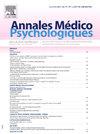两类专业人员对精神分裂症污名化的比较分析
IF 0.5
4区 医学
Q4 PSYCHIATRY
引用次数: 0
摘要
研究目的本研究具有双重目的。一方面,它旨在比较两组在不同环境下为精神分裂症患者提供服务的专业人员:精神科服务人员和社会服务人员,以考察精神分裂症患者在不同指标上的耻辱感。另一方面,该研究还试图对显性污名化指标和隐性污名化指标进行比较。研究中使用了显性的成见指标,如歧视量表和社会距离,以及对这些人的刻板印象。根据刻板印象内容模型,个人或群体可从两个维度进行分类:温暖和能力。温暖指的是人际交往意图和社会或道德品质,而能力则涉及个人实现目标的动机或能力。此外,还采用了 "非人性化 "指标来衡量这些疾病的隐性耻辱感。非人性化理论区分了初级情感和次级情感,后者是人类特有的情感,并认为人们倾向于认为外群体成员不如内群体成员有人性。例如,与内群体成员相比,人们对某些外群体成员的积极或消极情绪的具体人类化程度较低。方法我们从精神科服务机构和社会服务机构两类机构招募了 91 名专业人士(护士、医生/精神病医生、社会工作者和心理学家),随机要求他们填写一份有关精神分裂症的在线问卷。我们使用了四个成见量表来测量歧视和社会距离、刻板印象(温暖和能力)以及非人性化。此外,我们还测试了社会人口变量以及社会主导取向。社会支配取向是一个概念,指的是个人在社会关系中偏好等级制度,即某些群体支配其他群体,并认为这种不平等应得到维护和合理化。结果首先,描述性分析表明,与精神障碍患者打交道的人的总体得分表明,精神分裂症患者受到中度鄙视。能力和温情的得分也处于平均水平,表明从事精神障碍患者工作的专业人员中度认同精神分裂症患者表现出温情和能力特质。另一方面,所得分数显示出轻微的非人性化。换句话说,无论职业背景如何,受试者都认为自己比精神分裂症患者更具有人性。此外,研究还发现,机构类型对所有四种歧视测量结果都有明显的影响。首先,医院的精神卫生专业人员比社会服务机构的专业人员更歧视精神分裂症患者。此外,他们对在专业安置协会工作的参与者的能力评价明显较低,但对他们的热情评价较高。最后,医院精神卫生专业人员的非人性化得分较高,而其他专业人员的非人性化得分则低得多。最后,歧视度量、温暖度和能力归因是相关的,而非人性化则不相关。社会主导倾向也与歧视和能力相关,但与非人化和温暖无关。这项研究的结果表明,使用不同的指标来衡量与精神障碍相关的成见是有价值的。非人性化的微妙测量方法为心理健康领域的研究开辟了新的途径。本文章由计算机程序翻译,如有差异,请以英文原文为准。
Analyse comparative de la stigmatisation de la schizophrénie chez deux publics de professionnels
Objectives
The aim of this study is dual. On the one hand, it aims to compare two groups of professionals working with individuals with schizophrenia in different settings: psychiatric services and social services, in order to examine the stigma of schizophrenia across various indicators. On the other hand, it also seeks to compare explicit measures of stigmatization with more implicit ones. Explicit indicators of stigma were used, such as the scale of discrimination and social distance, as well as stereotypical traits attributed to these individuals. According to the stereotype content model, individuals or groups can be categorized along two dimensions: warmth and competence. Warmth refers to interpersonal intentions and social or moral qualities, while competence concerns individuals’ motivations or abilities to achieve their goals. An indicator of infrahumanization was also employed to measure the implicit stigma of these disorders. The theory of infrahumanization distinguishes between primary and secondary emotions, the latter being specific to humans, and posits that people tend to perceive outgroup members as less human than ingroup members. For example, people attribute fewer specifically human positive or negative emotions to members of certain outgroups compared to ingroup members.
Methods
We recruited 91 professionals (nurses, physicians/psychiatrists, social workers, and psychologists) from two types of facilities: psychiatric services and social services, who were randomly asked to complete an online questionnaire on schizophrenia. We used four scales of stigma measuring discrimination and social distance, stereotypes (warmth and competence), and infrahumanization. Sociodemographic variables as well as social dominance orientation were also tested. Social dominance orientation is a concept that refers to an individual's preference for hierarchy in social relations, where certain groups dominate others, and the belief that such inequalities should be maintained and justified. It leads to the adoption of beliefs that legitimize and perpetuate discrimination against people with schizophrenia.
Results
First, the descriptive analyses show an overall score for individuals working with people suffering from mental disorders that indicates that individuals with schizophrenia are moderately stigmatized. The competence and warmth scores attributed are also average and suggest that professionals working with people suffering from mental disorders are moderately agree that users with schizophrenia exhibit traits of warmth and competence. On the other hand, the obtained score reveals slight infrahumanization. In other words, participants, regardless of professional context, attributed more specifically human traits to themselves than to individuals with schizophrenia. Furthermore, a significant effect of the type of facility was found for all four discrimination measures. Firstly, mental health professionals in hospitals discriminate more against individuals with schizophrenia than professionals in social services. Moreover, they attribute significantly less competence, but more warmth to participants working in professional insertion associations. Lastly, the score of infrahumanization was higher among mental health professionals in hospitals, while it was much lower among other professionals. Finally, discrimination measures, warmth, and competence attribution are correlated, whereas infrahumanization is not. Social dominance orientation is also correlated with discrimination and competence but not with infrahumanization and warmth.
Conclusions
The various indicators of stigma show that they vary depending on the type of facilities in which professionals working with individuals with schizophrenia operate. The results of this study demonstrate the value of using diverse indicators to measure stigma associated with mental disorders. The subtle measure enabled by infrahumanization opens up new avenues of study in the field of mental health.
求助全文
通过发布文献求助,成功后即可免费获取论文全文。
去求助
来源期刊

Annales medico-psychologiques
医学-精神病学
CiteScore
1.30
自引率
33.30%
发文量
196
审稿时长
4-8 weeks
期刊介绍:
The Annales Médico-Psychologiques is a peer-reviewed medical journal covering the field of psychiatry. Articles are published in French or in English. The journal was established in 1843 and is published by Elsevier on behalf of the Société Médico-Psychologique.
The journal publishes 10 times a year original articles covering biological, genetic, psychological, forensic and cultural issues relevant to the diagnosis and treatment of mental illness, as well as peer reviewed articles that have been presented and discussed during meetings of the Société Médico-Psychologique.To report on the major currents of thought of contemporary psychiatry, and to publish clinical and biological research of international standard, these are the aims of the Annales Médico-Psychologiques.
 求助内容:
求助内容: 应助结果提醒方式:
应助结果提醒方式:


